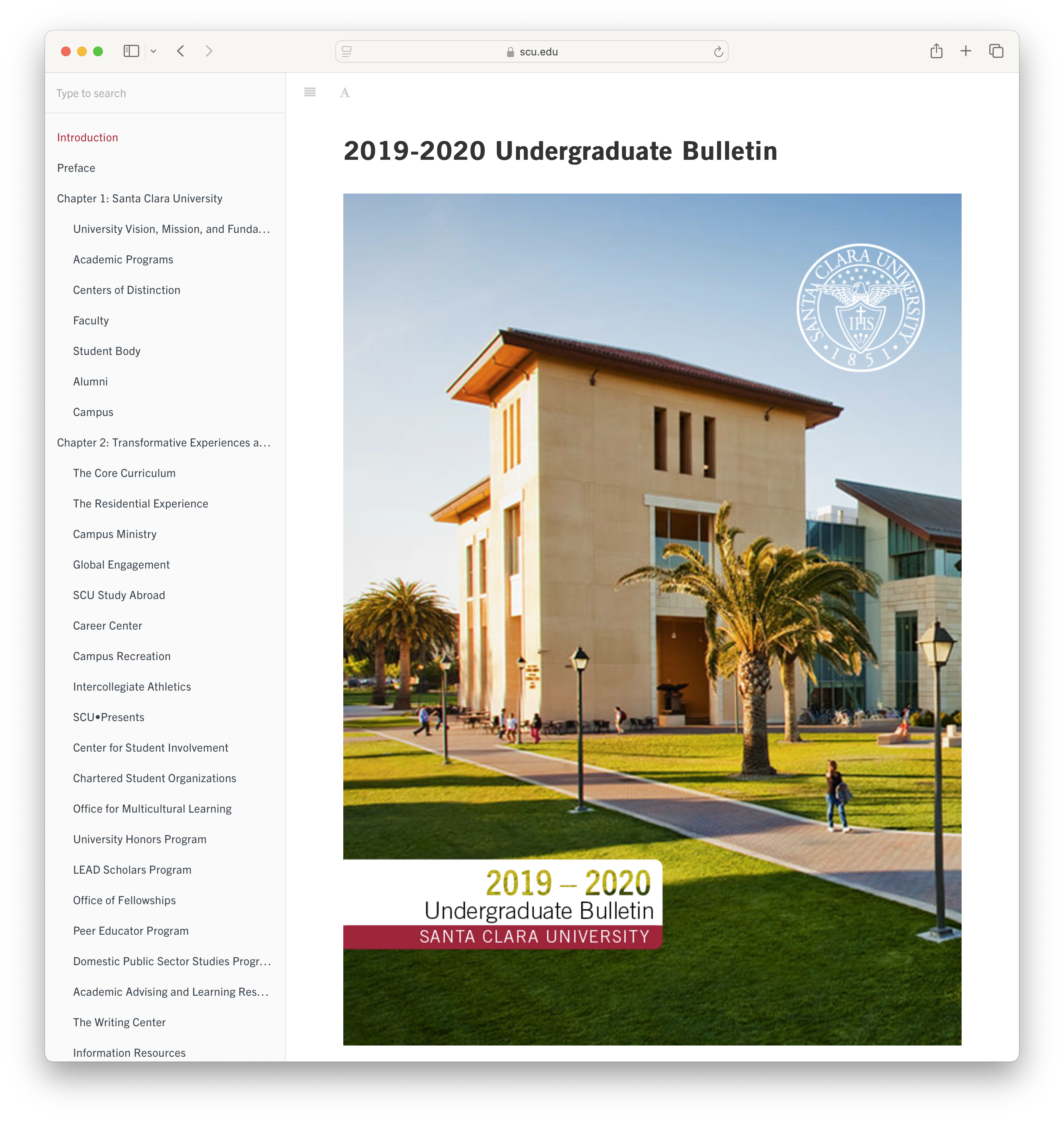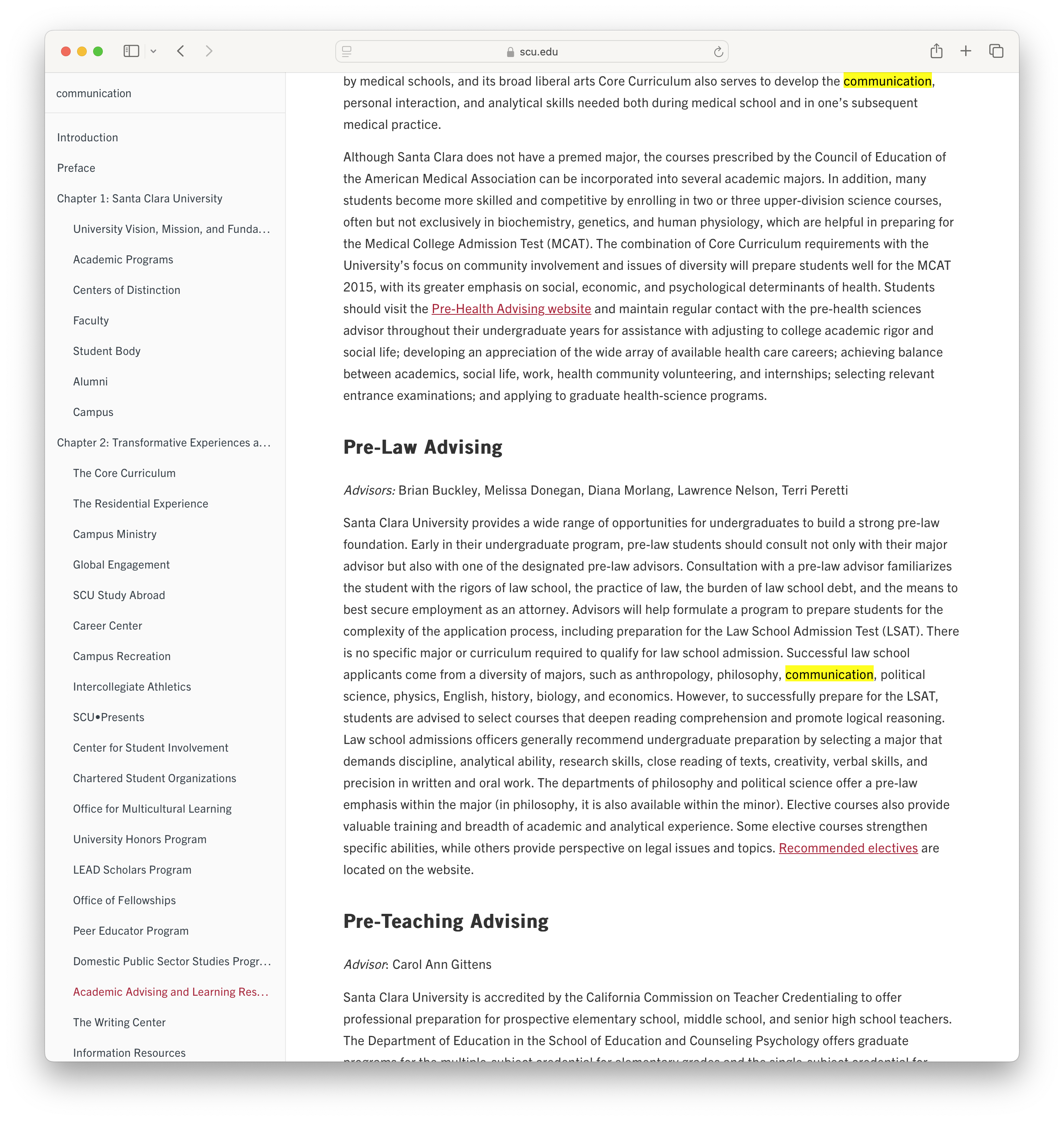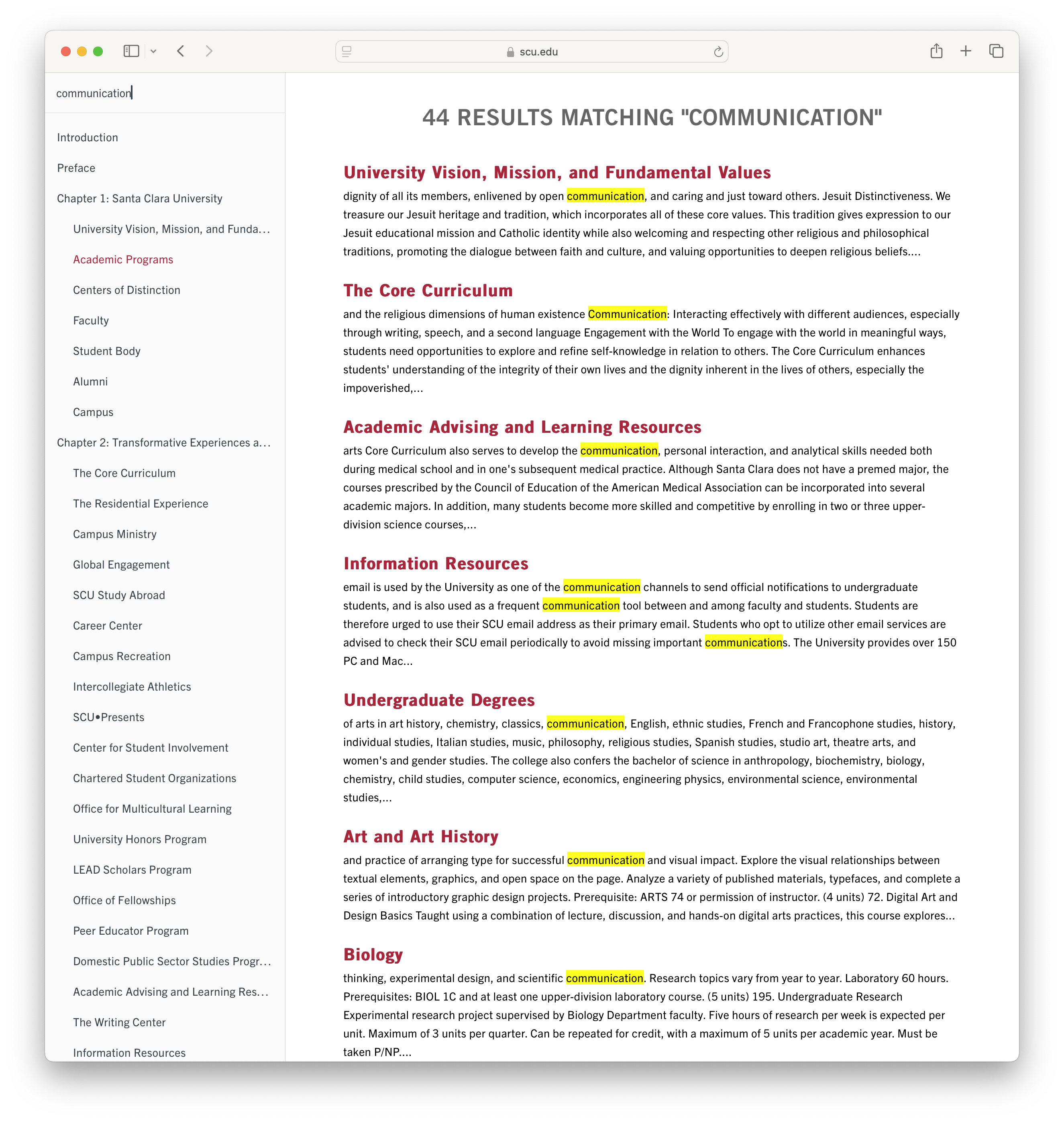SCU Bulletin



Check out the bulletin. 2019-2020 SCU Undergraduate Bulletin.
Improving a painful process
If you are a college student, how do you know what your core requirements are? What classes do you need to take if you are a Communication major, and how many units do you need to graduate?
Students received a novel-sized publication every year that helped them understand their academic journey—the Undergraduate Bulletin—to serve as the source of truth for academic programs, university centers, and policies. It helped students, faculty, and staff answer questions, resolve disputes, and help guide decisions that could shape a student’s career. However, the existing bulletin system faced several critical challenges:
- Resource Intensity: At nearly 700 pages in print, the bulletin’s production was extremely resource-intensive.
- Complex Collaboration: The project required extensive collaboration across the entire university, involving multiple departments and stakeholders.
- Time-Consuming Process: The art, content creation, and production processes were long and arduous.
- High Costs: Print costs averaged over $60K per year.
- Outdated Information: Due to its static nature, the printed bulletin became outdated as soon as it was published, limiting its usefulness throughout the academic year.
Ultimately, we needed to transform the bulletin process and product into a digital solution.
The Bulletin as a product
The goal was to provide a functional and aesthetic experience that helped users find what they needed quickly and easily.
- Completely Online: Transition the entire production process from print to digital, eliminating the need for physical copies.
- Online Collaboration: Facilitate seamless collaboration among university departments and stakeholders through online platforms.
- Cost and Time Efficiency: Significantly reduce the time and financial resources required for bulletin production.
- Enhanced Accessibility: Create a mobile-friendly, easily searchable document that would be more user-friendly than its print counterpart.
- Real-time Updates: Enable the ability to update information in real-time, ensuring the bulletin always contains the most current information.
The primary objectives of this initiative were to:
- Improve the accessibility and usability of the bulletin for all users
- Use behavioral data to understand how the bulletin is used and when
- Streamline the bulletin production process
- Reduce costs associated with printing and distribution
- Keep information up-to-date throughout the year
- Leverage digital technologies to create a more efficient and collaborative workflow
From vision to strategy
The implementation of the digital transformation for the undergraduate bulletin followed a strategic, user-centered approach:
User Research and Process Analysis
- Identified key stakeholders: faculty, staff, students, and external resources like copywriters.
- Interviewed users across personas to understand how they use the bulletin, and for contributors, how they facilitate collaboration on their sections.
- Considered the competitive landscape: how are other institutions solving this problem? How has this been solved in electronic publishing? What technology can we borrow from Apple Books or Kindle?
Technology Selection and Integration
- Converted Word documents to Google Docs to utilize real-time collaboration features
- Leveraged existing Google Suite infrastructure to improve collaboration
- Identified and implemented GitBook, an open-source solution that converts markdown files into mobile-friendly, accessible digital documents
Iterative Development and Testing
- Adopted an iterative approach, starting with a single chapter
- Built an end-to-end prototype using GitBook
- Conducted user testing with students and staff to ensure the new format met our goals
Workflow Optimization
- Streamlined the content creation and editing process
- Enabled direct collaboration between faculty, staff, and copywriters through Google Docs, brought contributors along with the process with training and office hours
- Implemented a more efficient workflow from content creation to final publication using GitBook
Accessibility and Performance Focus
- Utilized GitBook’s minimal HTML and JavaScript rendering to ensure fast load times and improved accessibility
Results and Impact
The digital transformation of the Santa Clara University undergraduate bulletin yielded significant positive outcomes across multiple areas:
Improved User Experience
- Students benefited from an easily accessible, intuitive digital interface purpose-built for documentation
- Enhanced search functionality allowed for quick information retrieval
- Mobile-friendly design increased accessibility across devices
Efficiency Gains
- Eliminated weeks of labor associated with the traditional print process
- Streamlined collaboration between staff and faculty, reducing back-and-forth communications
- Enabled quicker implementation of yearly changes
Cost Savings
- Substantial reduction in printing and distribution costs over multiple years
- Decreased labor costs due to improved efficiency
Environmental Impact
- Significant reduction in paper usage, contributing to the university’s sustainability goals
Real-time Updates
- Ability to make immediate updates ensured the bulletin always contained the most current information
Collaborative Workflow
- Staff and faculty experienced a more streamlined, collaborative process for content creation and revision
Accessibility
- The digital format, combined with GitBook’s minimal HTML and JavaScript rendering, improved accessibility for users with diverse needs
The transformation addressed the initial challenges and brought about additional benefits, positioning the undergraduate bulletin as a more effective, user-friendly, and sustainable resource for the entire university community.
Challenges and Lessons Learned
While the digital transformation of the undergraduate bulletin was largely successful, there were some challenges and important lessons learned:
Challenges:
- Technical Integration: The transition from Google Docs to GitBook required some manual intervention; building the product took some knowledge of the different systems and products, and the automations needed to be kicked off manually.
- Long-term Sustainability: While the solution was creative and practical, the open source product at the core of the documentation went closed-source, necessitating a new technical solution.
Lessons Learned:
- Plan for Scalability: When implementing custom solutions, planning for scalability from the outset is crucial. This includes considering how the process can be managed and executed by team members with varying levels of technical expertise.
- Admin Interface: Building an admin-facing interface for managing the transition between platforms could have improved the process’s longevity and accessibility.
- Documentation is Key: Thorough documentation of complex processes is crucial, but it’s equally important to design intuitive systems to reduce reliance on extensive documentation.
- Consider Future Handoffs: When designing processes, consider how they might be handed off to other team members or departments.
These lessons highlight the importance of balancing innovation with practicality and long-term sustainability in leadership. They have informed subsequent design initiatives by emphasizing the need for scalable, user-friendly solutions that can be easily maintained and transferred within an organization.